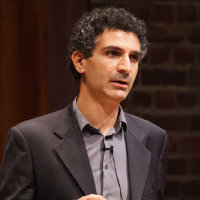IEEE Talks IoT: Raffaele Giaffreda

Raffaele Giaffreda is the Head of Smart IoT research group at CREATE-NET and former Coordinator of EU FP7 13m€ collaborative project iCore, merging IoT and Cognitive Computing, and serves as the Editor-in-Chief of the IEEE IoT eNewsletter. He is an IoT subject matter expert and discusses the opportunities around IoT-based automated monitoring applications and how more work should be done around IoT in the education sector.
Question: Where do you see the most obvious opportunities for the Internet of Things?
Raffaele Giaffreda: Since the nature of IoT is very much tied to deploying cheap hardware in high volume, it’s automated monitoring. It could be monitoring people or monitoring utilities. It could be monitoring equipment in a corporate environment for loss/theft prevention. It could be hospitals tracking medical devices. You can also monitor various components of bigger items (think of vehicles, white goods etc.) to prevent further damage by notifying the owner when a part fails, or even before it fails, so it can be proactively replaced.
Question: Monitoring people is a big part of IoT. What scenarios do you envision?
Giaffreda: There are a lot of health-related applications that are driven by an aging society and challenges associated with having to look after people because they are living longer. Ideally, we’d like them to be able to stay in their own homes longer before they have to be hospitalized. That of course ties into home monitoring, which is already one of the biggest segments.
Question: How do you see automated monitoring scaling up?
Giaffreda: From people monitoring and home monitoring you scale up to managing the utilities in wider cities, where there are already clear business models emerging. For example, a lighting infrastructure that allows you to dim lamp posts in accordance with the available light outside means you can recoup the cost of deploying that infrastructure quickly as well see savings in energy. This technology can in turn be applied to other city-wide infrastructure such as traffic management, and in turns opens up more opportunities to provide services to citizens, such as water and waste management.
Question: What particular components or technologies within monitoring need to be addressed to fully realize these monitoring scenarios?
Giaffreda: The jury is still out of what types of technologies are best for this type of monitoring. Take the communications part, for example. You can use cellular-like technologies, which provide a large coverage with one tower, but then you have a very low bandwidth. The amount of data you can gather from the sensors deployed in this huge area is fairly limited. The flip side is there are short range communication technologies that are better suited for higher bit rates but require more energy, which can be addressed using energy harvesting. There are trade-offs.
Question: Do we need a great deal of new technologies to realize these opportunities?
Giaffreda: The general feeling is we should exploit existing technologies. We are at the stage where you can find a suitable technology for whatever you want to do with IoT. We need to make sure different application domains can pick the right technologies and deploy them in a sustainable way from a return-on-investment point of view.
Question: Given the role of the Internet in IoT, there’s a lot of emphasis on networking communications technology, but are there other technologies that just as critical in your mind to advancing IoT?
Giaffreda: We certainly wouldn't have IoT without networking technology. But we also have to think about processing information quickly and effectively. This is where we start touching on things like advances within cloud computing to process the activity close to the edge to make sure individual data streams do not have to travel throughout the network to reach a central processing point. We will be looking at distributing the processing capabilities for ensuring that the traffic that billions of connected objects generate can be kept down by doing as much signaling or processing as close to the edge as possible.
Question: What areas of IoT do you feel are particularly interesting but do not garner a great deal of discussion?
Giaffreda: There's a lot more that could be done to push IoT within the education sector. Here in Europe, we are lagging behind in terms of using technologies to improve how students learn, but also empowering them to be more creative. On the creativity front, at this point in time it is all in the hands of the so-called “makers”: they can make hardware, they can program software, they can build widgets very easily, but we have to get further beyond what this small percentage of the population can do in terms of producing new applications and services. We have to empower students to easily exploit technology, which is what has been done in the smartphones world where people can easily customize and personalize their Android or iOS devices and where students learn more easily through the use of these devices. Use of IoT for monitoring how students learn can also be used to produce better and more personalised education programmes. There are a lot more steps ahead to make sure IoT becomes a little bit more mainstream in the education sector starting from high school and on to university.


